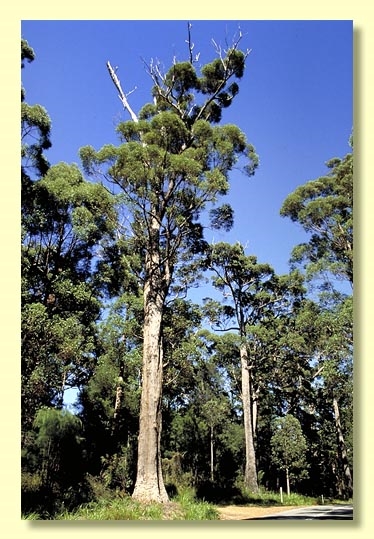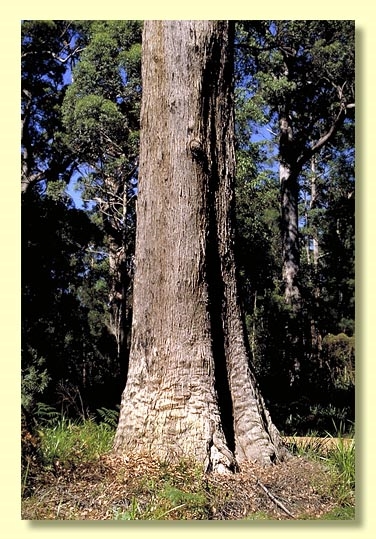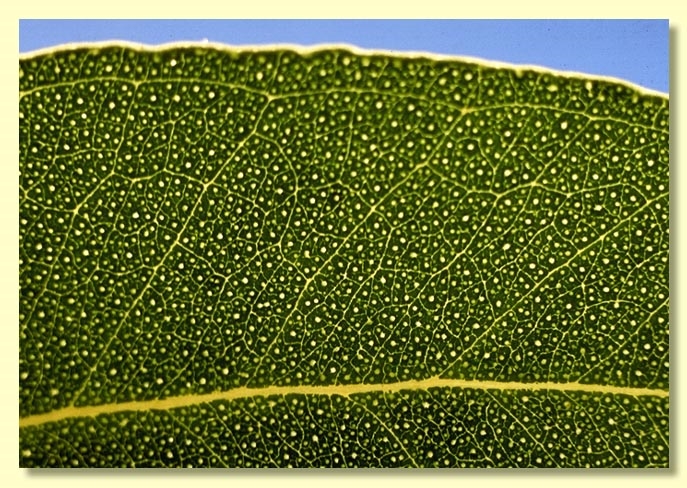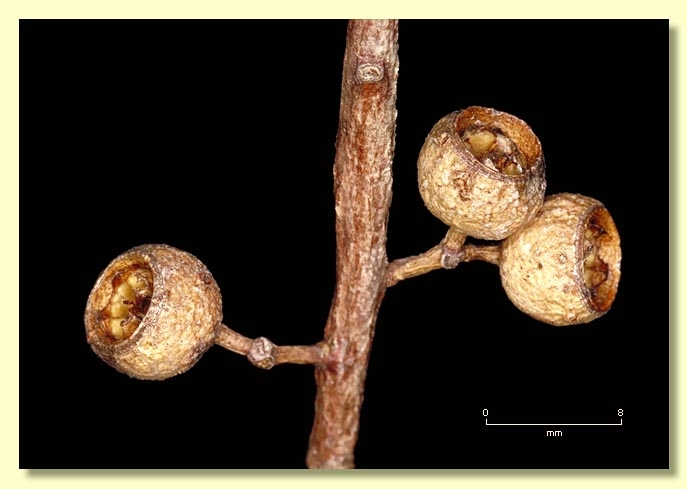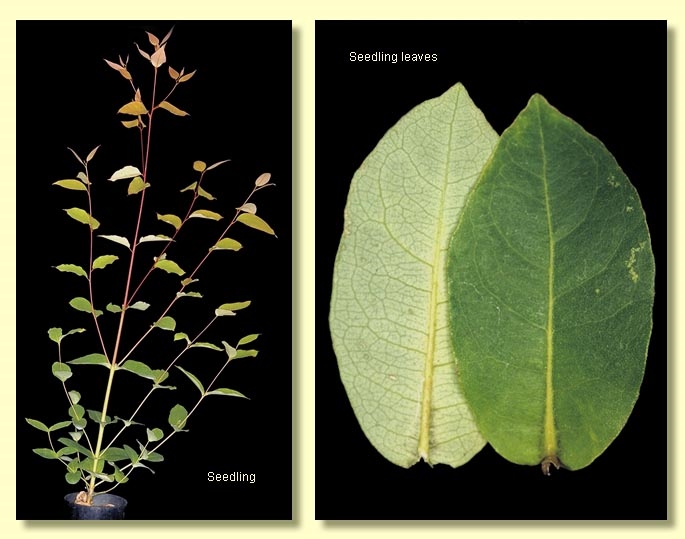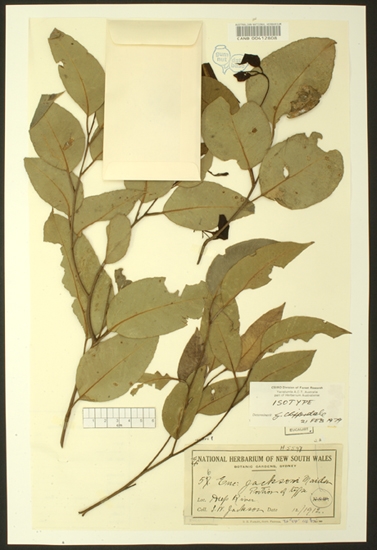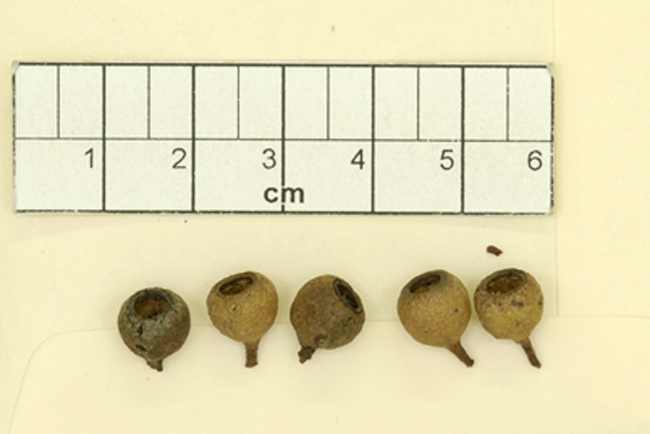Euclid - Online edition
Eucalyptus jacksonii
Eucalyptus | Eucalyptus | Longistylus | Arboreae | Jacksoniae
Bark rough to small branches, stringy, thick, somewhat brittle, grey over red-brown.
Branchlets lacking oil glands in the pith.
Juvenile growth (coppice or field seedlings to 50 cm): stems rounded in cross-section; juvenile leaves always petiolate, opposite at lower nodes but soon becoming alternate, broadly ovate, 12–17 cm long, 6–10 cm wide, discolorous, dark green above.
Adult leaves alternate, petioles 1–2 cm long; blade ovate to lanceolate, 6–9.5(11.5) cm long, 1.2–2.5(3) cm wide, base oblique or tapering to petiole, margin entire, apex a drip-tip, discolorous, only slightly glossy, dark green above, side-veins greater than 45° to midrib, reticulation dense, intramarginal vein remote from margin, oil glands numerous, island.
Inflorescence axillary unbranched, peduncles 0.8–1.2 cm long, buds 7 per umbel, pedicels 0.4–0.6 cm long. Mature buds elongated-ovoid, 0.7–0.8 cm long, 0.4–0.5 cm wide, scar absent, the single operculum bluntly to acutely conical, outer stamens erect, inner stamens inflexed, anthers reniform to oblong, versatile, dorsifixed, dehiscing by oblique confluent slits, style long and bent, stigma tapered, locules (3)4, the placentae each with 2 vertical rows of ovules. Flowers white.
Fruit pedicellate (pedicel 0.2–0.6 cm long), truncate-globose to shortly and obesely barrel-shaped, 0.8–1.1 cm long, 0.7–1 cm wide, disc descending vertically, valves (3)4, enclosed.
Seeds brown, 2–3.5 mm long, obliquely pyramidal, ventrally ridged, hilum terminal.
Cultivated seedlings (measured at ca node 10): cotyledons reniform; stems rounded in cross-section; leaves opposite, sessile, amplexicaul and elliptical for ca 6 to 8 nodes then becoming petiolate, alternate, ovate, 4.5–14 cm long, 2.5–7.5 cm wide, discolorous throughout, mid-green above, dull.
Flowering has been recorded in February.
A tall tree endemic to Western Australia, restricted to well-drained loamy soils in subcoastal river valleys near Walpole in the south-west of the state. The bark is rough, from the prominently buttressed base over the whole trunk to the branches. The adult leaves are discolorous, slightly glossy, dark green.
Within its natural range Eucalyptus jacksonii is distinguished from other rough-barked tree species by the combination of axillary inflorescences with buds in clusters of sevens, buds with a conical operculum, long style and all stamens fertile, and early seedling leaves sessile. Jarrah (E. marginata) differs from E. jacksonii in having longer, pointy buds and larger fruit. E. brevistylis differs in having delicate, rounded buds with a short style and infertile outer stamens.
Eucalyptus jacksonii belongs in Eucalyptus subgenus Eucalyptus section Longistyles, characterised by buds with a single operculum (hence no operculum scar), reniform anthers that shed pollen through slits that are confluent apically, ovules arranged in two rows on the placenta, plus the features outlined above. Species in subgenus Eucalyptus fall within two groups depending on how the stamens shed their pollen. One group, including E. jacksonii, E. marginata, E. staeri and E. brevistylis from Western Australia and the majority of species in subgenus Eucalyptus from eastern Australia, shed pollen though two anther slits that are joined at the top of the anther to form one long slit. Many other western species in subgenus Eucalyptus shed pollen from oblong anthers with slits that always remain separate.
There are three species with the common name of "tingle" occurring in the wetter eucalypt forests of the south-west of Western Australia, all rough-barked trees. (Tingle is a forestry term in common usage in Western Australia and is said to be of Aboriginal origin.) Two species—Rate's Tingle (E. brevistylis) and Red Tingle (E. jacksonii )—belong to Eucalyptus subgenus Eucalyptus, differing in floral and seedling features. The third tingle, E. guilfoylei, is called Yellow Tingle. E. guilfoylei is inEucalyptus subgenus Cruciformes and differs markedly from E. jacksonii in having terminal inflorescences, buds with an operculum scar (originally having 2 opercula the outer of which is shed before flowering) and ovules in four to six rows on the placenta.

